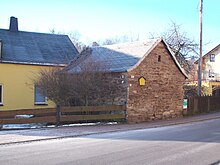Mühlberg (Schneeberg)
Mühlberg is a part of the municipality of the mountain town of Schneeberg in the Ore Mountains District . It was incorporated into Neustädtel in 1863 and has belonged to Schneeberg since Neustädtel was incorporated in 1939.
Geographical location
The district lies on the slope of the eponymous Mühlberg (520 m), one of the three heraldic mountains of the mountain town of Schneeberg. The Lindenauer Bach and the Griesbach, the two source brooks of the Schlemabach, flow at the foot of the mountain . The location is now in the urban area of Neustädtel and Schneeberg.
history
Little is known about the history of the independent village of Mühlberg, as it has always been in the shadow of the important mining towns of Schneeberg and Neustädtel. Around 1550 it was under the jurisdiction of the city council of Schneeberg, but did not belong to the city. The scattered settlement consisted of seven houses around 1612 and at that time belonged to the Niederschlema manor . The office responsible for the place was initially the Zwickau office , from 1816 the Schwarzenberg office and from 1843 the Kirchberg office . During this time 348 people lived in Mühlberg. From 1856 the Schneeberg court office was responsible for the place.
The place issued several requests to be attached to the city of Schneeberg, all of which were rejected. In 1863, the impoverished Mühlberg was incorporated into the mountain town of Neustädtel and in 1875 became part of the Schwarzenberg administration . Between 1874 and 1878 Wilhelm Liebknecht and 1889 August Bebel spoke in the former workers' pub , the Grüne Laube , in which the social democratic electoral association was founded in 1890 .
In 1939 Neustädtel and Mühlberg were forcibly incorporated into Schneeberg. In the 1930s the shot shaft was built on the Mühlberg, which existed until the uranium mining in the Schneeberg district in the 1950s. The "Eiserner Landgraf" treasure trove in the forest road is still a witness to the older mining era.
religion
Although Mühlberg belonged to Neustädtel politically and ecclesiastically, some of the residents had their church and school roots in Schneeberg.
tourism
The well-known Berghotel Steiger is located on the Mühlberg. There is a painting of a mountain parade on the facade of the house. The Chinese pagoda on Karlsbader Strasse in the garden of Steiger Sieber was built in 1771/72 by the merchant Christian Heinrich Richter. Due to a famine, he had the surrounding pit area converted into a garden.
Infrastructure
The new main building of the Schneeberg volunteer fire brigade was built at the foot of the Mühlberg in the 1990s.
traffic
Since the partial bypass of the Schneeberg district has been approved, the Mühlberg is affected by the federal highway 93 . The freight shed of the Schneeberg-Neustädtel station of the Schlematalbahn was on the ground of the community of Mühlberg.
literature
- Oliver Titzmann: A historic hike through the Schneeberg-Neustädtler mining landscape. Bad Schlema 2007, pp. 28/29 and 34/35.
- Wolfram Keßler, Martin Ebert: 1859–1989 - 130 years of the railway in the Schlema valley. Schlema Municipality Council, 1989, DNB 931092604 , p. 31.
- Uwe Gering (Ed.): Schneeberg. Gering-Verlag, Königstein / Taunus 1994, p. 33.
- Hans-Georg Türke: Saxon hiking guide. Volume 5: Western Ore Mountains and Zwickauer Land. 1st edition. Chemnitzer Verlag, 2011, ISBN 978-3-937025-60-5 , p. 38f.
Web links
- Mühlberg in the Digital Historical Directory of Saxony




